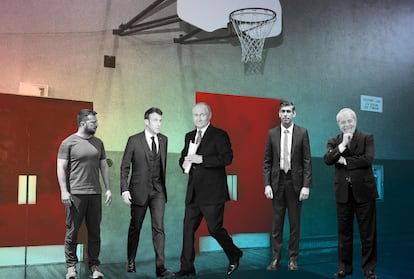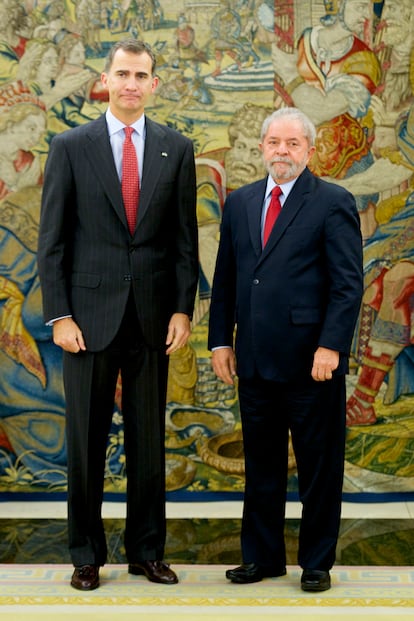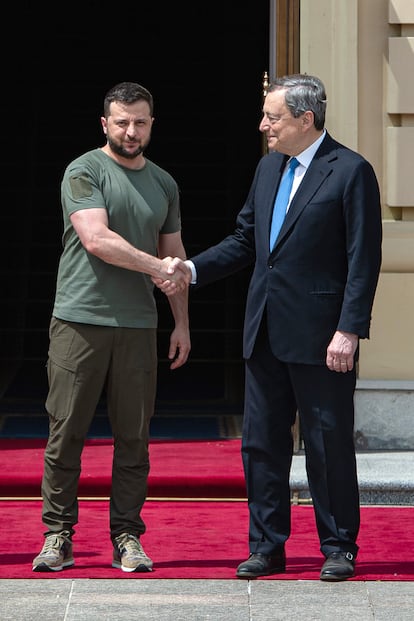Does height matter in politics?
Rishi Sunak, Lula da Silva, Emmanuel Macron, Volodymyr Zelenskiy and even Vladimir Putin are shorter than the average man – a characteristic that, despite not being relevant to governance, continues to challenge old ideas about leadership


Emil Ludwig, one of Napoleon Bonaparte’s biographers, noted that the French emperor had the tendency to surround himself with very tall men, such as members of the Imperial Guard. This apparently harmed his image, by causing him to look small and plump by contrast… even though this was not the case.
When Napoleon died in 1821, he measured 5ft 5-and-a-half inches – making him about two inches taller than the average Frenchman of the era. Despite this, even two centuries later, he is portrayed in popular culture as being tiny. And of course, an entire inferiority complex based on his stature is the supposed explanation for his aggressive, cynical and narcissistic character.
A few days ago, Australian journalist Tom Gara started a Twitter thread dedicated to a new batch of European political leaders who barely surpass Napoleon’s height. With the recent addition of British Prime Minister Rishi Sunak (5′6), the club of “short kings” – which includes Emmanuel Macron, Olaf Scholz, Volodymyr Zelenskiy and Vladimir Putin – has grown larger.
“We are entering a new Napoleonic era,” one of the Twitter users proclaimed. Another reminded Gara that there was precedence for this – François Hollande, Nicolas Sarkozy, Silvio Berlusconi and Angela Merkel governed France, Italy and Germany in recent years. When someone had the good sense to ask about the relevance of height in politics – “What does stature have to do with management capacity?” – they were quickly drowned out by an online debate over whether Macron is 5′6 or 5′7.
The obsession over height and power isn’t restricted to Europe. Last Sunday, former president Luiz Inácio Lula da Silva – popularly known as “Lula” – won Brazil’s elections. The 77-year-old leader of the Workers’ Party – who measures about 5′4 – will begin a third term in 2023 after defeating incumbent President Jair Bolsonaro, a 6′1 giant by comparison, who towered over Lula in the debates.
Lula joins other short leaders in the region. Peru’s President Pedro Castillo is about his height. Chilean President Gabriel Boric is barely a couple of inches taller.
A brief Googling suggests Rishi Sunak, Emmanuel Macron, Olof Scholz, Vladimir Putin and Volodymyr Zelensky are all 5'7, it's an unprecedented consolidation of European power in the hands of short kings
— Tom Gara (@tomgara) October 24, 2022

All of the aforementioned leaders, however, aren’t even close to being the shortest heads of state in history. The President of the Republic of Ireland, Michael D. Higgins – who was 5′3 when he took office in 2011 – recently joked that he has probably shrunk over the past decade, considering that he is now 81-years-old. The North Korean tyrant, Kim Jong-un, is 5′1… even taller than former Iranian president Mahmoud Ahmadinejad. The conservative politician was hand-picked by Iran’s Supreme Leader on two occasions, despite his very modest height of five feet. Ahmadinejad – who is currently part of the regime deploying deadly force against protestors – is, by all accounts, the record-holder.

For Jorge Francisco Santiago – director of the Master’s Degree in Image Consulting and Political Consulting at Camilo José Cela University in Madrid – there is no significant correlation between “centimeters and political success” – but he acknowledges that there are undoubtedly “ingrained social perceptions or false generalizations” that tend “to associate height with virility, or attribute ambition, aggressiveness or cunning to short men.” But Santiago considers that height doesn’t ultimately cause someone to “win or lose elections, because the vast majority of citizens understand that political competence, honesty, empathy, or even charisma do not depend on something as superficial as height.”
In spite of everything, a political adviser will always take into account “any unusual physical characteristics of the politicians he advises,” Santiago explains. The reality of perception can’t be totally ignored, especially when it comes to “debates and campaign events.” Resources are certainly devoted to counteract significant height differentials between candidates.
“In televised debates specifically, campaign managers and image consultants fight tooth and nail to hash out conditions that are as favorable to their candidate as possible.” Many things are up for discussion, from whether they will be “sitting or standing… to the height and dimensions of podiums or lecterns, to the arrangement of chairs.”

While Santiago notes that these are “perhaps not crucial details,” they are important from the point of view of political strategy and communication, as was made clear in the recent Brazilian presidential debates.
“Bolsonaro was interested in getting closer to Lula da Silva, even looking for a certain physical contact, to highlight the difference in height and thus reinforce his image as an energetic, determined and powerful man.” Lula avoided proximity at all times “with the instinct of an experienced politician, who knows himself well and has acquired the habit of avoiding any image that could harm him even a little bit.”
Santiago has so much experience with campaigns that he can spot details that are beyond the average observer. “When I see a predominance of low-angle images in the videos or on campaign posters, I already sense that the candidate is most likely below-average height, because that’s one of the most common techniques to hide it.” He thinks for a moment. “Also the use of tight clothing or shorter ties.”
Santiago recalls the 2004 US presidential election, which saw incumbent George W. Bush (5′10) fending off a much taller challenger, Senator John Kerry (6′3). “Bush’s advisers made a tremendous effort to make this difference not so evident, in a context in which the Republican candidate wanted to project an image of strength, consistent with his aggressive foreign policy.”
“Bush’s people found unexpected help in the body language of John Kerry – he’s one of those tall men with the tendency to stoop, so as not to give the impression of abusing his height. This unconscious gesture of humility hurt him, because it made him look uncomfortable in his own skin.”
Height consciousness was also a major factor in the French presidential election of 2007, which saw Nicolas Sarkozy (5′5) face off against Segolène Royal (5′7), “a woman of above-average height.” The conservative candidate – who ultimately won by a narrow margin – strived to “embody certain masculine values… with the lack of stature being mortifying to him.” Sarkozy would go on to marry Italian-born model Carla Bruni, who, at 5′9, made him even more obsessed with controlling public perceptions about his height.
In the end, however, unlike the presidents who succeeded him – Hollande and Macron – Sarkozy failed to neutralize discussion about his height… probably because he was so obsessed with it. Details emerged in the media about how he wore lifts in his shoes and stood on tiptoe in photographs with other world leaders. All of this made him appear like a vain man suffering from an inferiority complex.
In Santiago’s opinion, “any potentially problematic characteristic – be it above-average or below-average height, shyness, or a lack of conventional physical attractiveness – is a challenge from the point of view of image, but it can be countered naturally and intelligently.”
He insists that even the Napoleonic stereotype can be turned into an advantage: “A person whose height is below-average sometimes has to work harder to project their personality more effectively.” That strategy worked in the early days of Sarkozy’s career and keeps serving leaders like Lula today. But Santiago is unsure “if it’s working with this new generation of shorties, such as Scholz or Sunak,” who are far more reserved.
Nevertheless, if Napoleon were to stand for election in today’s democratic Europe – and if he had a team of image consultants – perhaps he would think twice before surrounding himself with such tall bodyguards.
Tu suscripción se está usando en otro dispositivo
¿Quieres añadir otro usuario a tu suscripción?
Si continúas leyendo en este dispositivo, no se podrá leer en el otro.
FlechaTu suscripción se está usando en otro dispositivo y solo puedes acceder a EL PAÍS desde un dispositivo a la vez.
Si quieres compartir tu cuenta, cambia tu suscripción a la modalidad Premium, así podrás añadir otro usuario. Cada uno accederá con su propia cuenta de email, lo que os permitirá personalizar vuestra experiencia en EL PAÍS.
¿Tienes una suscripción de empresa? Accede aquí para contratar más cuentas.
En el caso de no saber quién está usando tu cuenta, te recomendamos cambiar tu contraseña aquí.
Si decides continuar compartiendo tu cuenta, este mensaje se mostrará en tu dispositivo y en el de la otra persona que está usando tu cuenta de forma indefinida, afectando a tu experiencia de lectura. Puedes consultar aquí los términos y condiciones de la suscripción digital.
More information
Archived In
Últimas noticias
From digital curfews to blocking apps: How technology experts protect their children online
Why the price of coffee has skyrocketed: from Brazilian plantations to specialty coffee houses
Confined to a Cuban hospital: When electricity is a matter of life or death
How Japan is trying to avert ‘digital defeat’
Most viewed
- Pablo Escobar’s hippos: A serious environmental problem, 40 years on
- Reinhard Genzel, Nobel laureate in physics: ‘One-minute videos will never give you the truth’
- Why we lost the habit of sleeping in two segments and how that changed our sense of time
- Charles Dubouloz, mountaineering star, retires at 36 with a farewell tour inspired by Walter Bonatti
- The Florida Keys tourist paradise is besieged by immigration agents: ‘We’ve never seen anything like this’










































